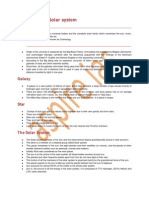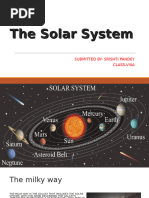Module 1 - Introduction To Planets
Uploaded by
killmobile16Module 1 - Introduction To Planets
Uploaded by
killmobile16Module 1: Introduction to Planets
What are Planets?
Planets are large celestial bodies that orbit a star, such as the Sun. They do
not produce their own light but reflect the light from their star. Each planet is
unique in its characteristics, including size, composition, and atmosphere.
Types of Planets
There are two main types of planets: terrestrial and gas giants. Terrestrial
planets, like Earth, Mars, Venus, and Mercury, have solid, rocky surfaces. Gas
giants, such as Jupiter, Saturn, Uranus, and Neptune, are mostly made of
gases and have no well-defined solid surface.
The Solar System
Our solar system consists of eight recognized planets that revolve around the
Sun. In order from the Sun, the planets are Mercury, Venus, Earth, Mars,
Jupiter, Saturn, Uranus, and Neptune. Each planet has its own orbit, taking
different amounts of time to complete one full revolution around the Sun.
Characteristics of the Inner Planets
The inner planets (Mercury, Venus, Earth, and Mars) are closer to the Sun.
They are smaller, have rocky surfaces, and are composed mainly of metals
and silicate rocks. Earth is unique because it supports life, while Venus has a
thick atmosphere that traps heat, making it the hottest planet.
Characteristics of the Outer Planets
The outer planets (Jupiter, Saturn, Uranus, and Neptune) are much larger
than the inner planets and are known as gas giants. Jupiter is the largest
planet In our solar system and has a strong magnetic field. Saturn is famous
for its beautiful rings, while Uranus and Neptune are known as ice giants
because they contain icy materials.
Planetary Atmospheres
Most planets have atmospheres made up of gases. Earth’s atmosphere is
essential for life and contains oxygen. Venus has a thick atmosphere of
carbon dioxide, while Mars has a thin atmosphere with very little oxygen. The
gas giants have thick atmospheres primarily composed of hydrogen and
helium.
Moons and Rings
Many planets have natural satellites, called moons, that orbit around them.
For example, Earth has one moon, while Jupiter has over 79 known moons.
Some planets, like Saturn, also have spectacular ring systems made of ice
and rock particles.
Exploration of Planets
Scientists explore planets using telescopes and space missions. Space
probes, such as Voyager, Mars rovers, and the Hubble Space Telescope,
provide valuable information about the planets’ surfaces, atmospheres, and
potential for supporting life.
The Importance of Studying Planets
Understanding planets helps us learn more about the universe and our place
within it. It allows us to study the formation of our solar system, the potential
for life on other planets, and the effects of cosmic events on Earth.
You might also like
- Ivs233 Investment Property Under ConstructionNo ratings yetIvs233 Investment Property Under Construction7 pages
- Difinition and Discussions About Solar System and The 8 Planets in The Solar SystemNo ratings yetDifinition and Discussions About Solar System and The 8 Planets in The Solar System4 pages
- Basic Object in Our Solar System and Those BeyondNo ratings yetBasic Object in Our Solar System and Those Beyond40 pages
- Igcse (9 - 1) Physics Unit 8: AstrophysicsNo ratings yetIgcse (9 - 1) Physics Unit 8: Astrophysics17 pages
- Structure: Asteroid 3122 Florence Had Two Tiny MoonsNo ratings yetStructure: Asteroid 3122 Florence Had Two Tiny Moons2 pages
- BY Vidhya Natarajan: Star We Call The Sun, The Planets MercuryNo ratings yetBY Vidhya Natarajan: Star We Call The Sun, The Planets Mercury10 pages
- Solar System Facts - A Guide To Things Orbiting Our SunNo ratings yetSolar System Facts - A Guide To Things Orbiting Our Sun12 pages
- Unit Six 6. The Solar System 6.1. Family of The Solar System The Solar SystemNo ratings yetUnit Six 6. The Solar System 6.1. Family of The Solar System The Solar System10 pages
- Reading Planets 7th The-Solar-System-Reading-Material-Grades-6-8No ratings yetReading Planets 7th The-Solar-System-Reading-Material-Grades-6-85 pages
- Unit 6 - The Earth and The Universe-RUBENNo ratings yetUnit 6 - The Earth and The Universe-RUBEN13 pages
- 3632 Topper 21 110 1 23 7836 Our World Up201602221640 1456139411 6439No ratings yet3632 Topper 21 110 1 23 7836 Our World Up201602221640 1456139411 64394 pages
- Astronomy Is A Natural Science That Deals With The Study of Celestial Objects (SuchNo ratings yetAstronomy Is A Natural Science That Deals With The Study of Celestial Objects (Such8 pages
- 21 Century Lessons: The Slope of A LineNo ratings yet21 Century Lessons: The Slope of A Line44 pages
- Digestion, Nutrition, Metabolism - ANSWERNo ratings yetDigestion, Nutrition, Metabolism - ANSWER24 pages
- 2018 - sh330 6 sh330lc 6 sh350hd 6 sh350lhd 6 t350% (2)2018 - sh330 6 sh330lc 6 sh350hd 6 sh350lhd 6 t314 pages
- HASAN Syed Marzan Ul - Master Thesis - 7th Cohort - URONo ratings yetHASAN Syed Marzan Ul - Master Thesis - 7th Cohort - URO122 pages
- Ch17 - Additional Aspects of Aqueous EquilibriaNo ratings yetCh17 - Additional Aspects of Aqueous Equilibria12 pages
- P11X24EN Scania Opticruise and Retarder Tcm40 280864No ratings yetP11X24EN Scania Opticruise and Retarder Tcm40 2808646 pages
- Weppler CH, Magnusson SP.2010. Increasing Muscle ExtensibilitNo ratings yetWeppler CH, Magnusson SP.2010. Increasing Muscle Extensibilit15 pages
- D140806POGATAGenaroetal Appointment Experience PDFNo ratings yetD140806POGATAGenaroetal Appointment Experience PDF8 pages
- If You Token Leaked What You Have To Do?No ratings yetIf You Token Leaked What You Have To Do?5 pages
- Schneider Electric Case Study:: Accelerating Global Digital Platform Deployment Using The Cloud100% (1)Schneider Electric Case Study:: Accelerating Global Digital Platform Deployment Using The Cloud8 pages

































































































